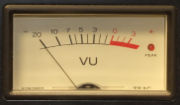

I found this tip at the beginning of my career, actually just before I was hired away from college to my first recording job. It was buried in a thick audio manual but made its way into the training I received. It seems that way back, BBC researchers discovered that the bandwidth of sounds affects their apparent loudness to the human ear when they are listened to serially (one after the other), and discovered a rule of thumb to allow you to understand and work with the apparent loudness differences between them. By way of background, the human voice is a narrow bandwidth sound, as are the guitar and many solo instruments. An orchestra or ensemble is a wide bandwidth sound, occupying everything from low bass to high treble.
Here's what the BBC researchers discovered: when run at 0db (full modulation), a wide bandwidth sound will appear to be 6db louder than a human voice or any other narrow bandwidth sound that follows it also at 0db (full modulation). A human voice or similar narrow bandwidth sound at 0db will be perceived as 6db quieter than a 0db wide bandwidth sound that follows. The opposite is true for wide bandwidth sounds following narrow bandwidth ones. That 6db difference is significant because a sound that is 6db louder than another is perceived by the human ear as about twice as loud.
So, how does this affect me when I mix?
If you begin an ensemble song with an ensemble intro at nearly full volume and then add a solo instrument above the ensemble, ducking the ensemble, it is often difficult to make that transition sound nice. The solo instrument often seems overwhelmed by the preceding ensemble. Now you know why. It is a common thing to want a punchy beginning for a song that requires some volume and then to introduce a voice or solo instrument. What to do about it?
Remember the 6db rule. That intro may need a little bit of level compromise at the beginning, but if you have the time between the beginning and the entry of the solo instrument, you can hit it pretty hard as long as you set either a mix trajectory or performance trajectory for it that deposits it at -6 db at the point where the solo instrument enters. As a result, the fade under from there will be pretty easy. The same goes for the location where the soloist exits and the ensemble takes over: Make sure you don't allow the ensemble to take over at full volume unless you want it to sound twice as loud as the solo instrument as an effect.
If you are mixing jingles with voice-overs for broadcast, the 6db rule will prevent you from fighting those transitions as well. Simply make sure the jingle is near -6db when the voice joins and then return there again when it ends. You can artfully sneak it down to and back up from this level.
I've found this secret of the mixing world, documented by the BBC, to be one of the most influential and helpful on my mixing transitions.